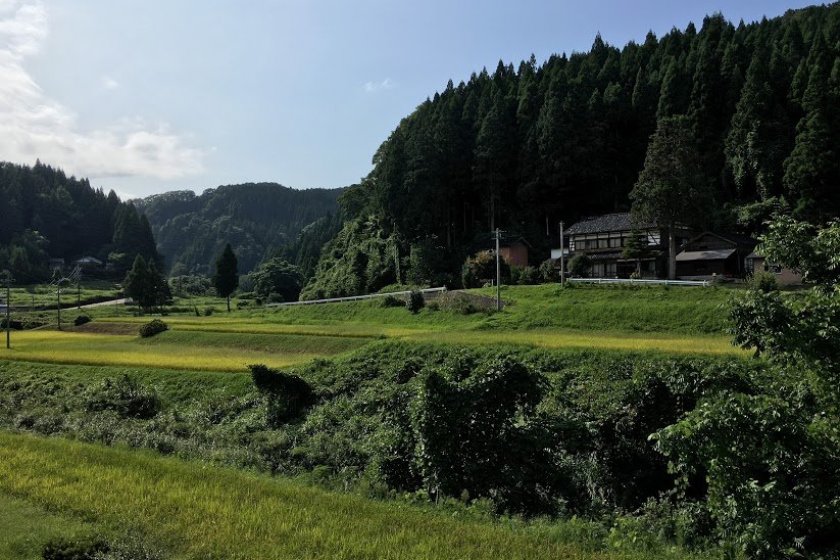What was rural farm life like a century ago in Japan? You can experience the answer to that yourself in the mountains near the small seaside town of Noto, the ideal place to connect with the rich agricultural heritage here. This place is also a base for exploration of the Noto Peninsula and its scenic coastlines, thriving markets, and traditional crafts. There is plenty to see and do in any season. Noto has a long history of fishing, and the adult yellowtail caught in winter, known as kamburi, are a standout. Other local products include soy sauce, sea salt, blueberries, strawberries, and sake, as well as festivals of fire, motivating monsters, and thanksgiving. And of course, the countryside is full of alluring rice fields interspersed with forested hills and mountains, making Noto a great destination for visitors looking to connect to Japan’s nature.

Highlights of the North
The northernmost part of Ishikawa Prefecture and the Noto Peninsula, known as Oku-Noto, stands out especially for its coastline, with picturesque views, beaches, and swimming areas. The outer coast, facing the Sea of Japan, has the most famous of the peninsula’s rugged terrain.
National Route 249 follows the outer coast and, heading west, takes you past Nafune Beach, where you’ll find Window Rock and Tarumi Falls, and then Sosogi Beach, with its sea-facing Shiroyone Senmaida rice terraces. The latter are a UNESCO site comprised of a thousand individually-owned paddies, beautiful in every season.
A little further down the road you’ll come to Wajima, which has a morning market that dates back a millennium to the Heian period and showrooms for its famous lacquerware.
Along the inner coast of the peninsula, the area is populated by fishing villages, where calmer waters aid the thriving local fishing industry. Koiji Beach is the nearest to the city of Noto and has white sand and gentle waves. Tsukumo Bay has an interesting drowned river valley known as a ria coast, this one comprised of 99 inlets.
Ancient traditions and festivals live on in Noto. Amamehagi is a winter festival where goblins or demons frighten the laziness out of children and increase motivation for the work to be done in spring. Also in winter, with the ritual of Aenokoto, farmers welcome the spirits of the rice fields into their homes before seeing them off in a gesture of gratitude. During the summer, Kiriko lantern festivals throughout the region light up the nights.

Experience a Noto farmstay
To get to the heart of this rural peninsular area, look further inland to Miyachi in the central mountains, where you can find the picturesque Shunran-no-Sato, or “Village of the Wild Orchids,” with over 40 farm houses—some with more than a hundred years of history. These are charming guesthouses where the locals are ready to welcome you. The eco-tourism initiative here was originally started with aim of reversing the trend of young people departing for big cities, leaving behind the older farming generations, and Shunran-no-Sato’s ability to provide a rural paradise in Japan has shown huge appeal to foreign visitors too.

Take part in the local agricultural way of life during your time here by picking berries, participating in rice planting, and making charcoal. For dinner, gather around the irori, an old-time sunken fireplace, for a meal served in fine Wajima lacquerware.
Other seasonal activities include hiking out in the mountains to gather edible wild plants in spring and beating the summer heat at the riverside then seeing the dazzling firefly displays in the evening.
In fall, mushrooms can be picked while taking in the autumn colors. And in winter, your hosts will show you how to make a cozy snow hut.
The meals offered at Shunran-no-Sato village follow a traditional dietary culture that has been admitted for Globally Important Agricultural Heritage status under the UN’s Food and Agricultural Organization. The wild yet edible sansai plants here form a core part of this cuisine and grow using the abundant clean water of the Noto area.
Rates for a stay at Shunran-no-Sato start from ¥4,860 per person (for a group of 3 more) without meals*, but to make the most of your stay dinner and breakfast comes recommended—being based on local ingredients and a vital part of connecting with Noto’s nature. Discounts are available for children of elementary school age or younger, as well as larger group bookings. Basic amenities are provided.
*Prices were true at the time of this article being written.





























